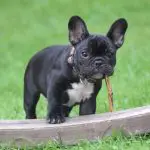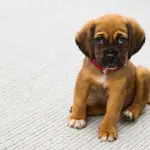Otterhound puppy and dog information
The Otterhound needs plenty of exercise and is considered a great jogging companion. Be sure to have her under control as she will go off after a scent. She was originally a pack animal so she generally gets along well with other canines. She may not do as well with other, smaller pets so be sure to socialize her with them as a puppy. She loves children but can be a bit clumsy and may upset or knock over toddlers. As a reminder, never leave a child unsupervised with a puppy or dog.
*Approximate Adult Size. The approximate adult size (two years old or older) of the Otterhound is 23 to 27 inches to the withers (highest point of the shoulder) and 65 to 120 pounds.
*Special Health Considerations. Most dog breeds have certain inherited health problems associated with that specific breed and the Otterhound id no exception. Although considered a very healthy dog, be on the look out for Canine Hip Dysplasia (genetic based looseness in the hip joint that can lead to arthritis pain and lameness), hemophilia and bloat (Gastric Dilation-Volvulus, the second leading killer of dogs, can kill within the hour, this space is too limited for a complete explanation but you should read up on this). Feeding more then once a day and avoiding exercise right after meals may help guard against bloat. This disease list is an informative guideline only. Other diseases may also be significant threats, please contact your veterinarian for a complete list.
She should visit the veterinarian several times in the first year for shots, boosters and check up. Then, as an adult, she should visit the veterinarian yearly for shots and check up. As she gets older, six years and on, she should visit the veterinarian twice a year for check ups and shots. Remember; avoid feeding your dog sweets.
*Grooming. The Otterhound has a double coat that has a messed up, shaggy appearance. The outer coat is hard and the inner coat is soft and furry. There is a protective oil on the coat which can have an odor. She should be brushed every couple of days. Brushing will help her maintain a clean and healthy coat, avoid mats and help you keep a closer eye on her health and strengthen your emotional bond with her. Her beard may need to be washed to rid it of dirt and food particles.
Her ears should be checked once a week and be kept clean. If you have her professionally groomed, make sure ear cleaning and inspection is part of the package. No water or excess fluid should get in the dogs ears, and do not try to irrigate the ears. Ear cleaning is too complicated and critical to instruct here. Look for hair growing in the ear canal, excess wax, or moisture. If her ears have a discharge, foul odor or she seems to be in distress and you suspect an infection, or tumor, consult your veterinarian.
Her teeth should be brushed at least twice a week with toothpaste and toothbrush designed for dogs. Brushing removes the accumulation of plaque and tartar which can cause cavities (rarely) and periodontal disease. Dog periodontal disease can lead to pain, loss of teeth, bad breath and other serious disease.
Her toenails may need to be examined for growth and clipped regularly. The toenails of the rear feet grow slower than the toenails of the front feet.
*Life Span. The Otterhound can live between 12 and 14 years with proper nutrition, medical care and excellent living conditions.
*History. The Otterhound comes from Great Britain where they were used in packs to kill river otters. They are very good trackers. They were first registered by the American Kennel Association in 1910.
Some Registries: *The Otterhound Club of America *UKC United Kennel Club *NKC National Kennel Club *CKC Continental Kennel Club *APRI Americas Pet Registry Inc. *AKC American Kennel Club *FCI Federation Cynologique Internationale *NZKC New Zealand Kennel Club *KCGB = Kennel Club of Great Britain *ANKC = Australian National Kennel Club *ACR = American Canine Registry
Litter Size: 7 to 10 Otterhound puppies
Category: Hound
Terms To Describe: Even tempered, friendly, lively,
*SPECIAL GOOD POINTS Good watch dogs. Get along well with other dogs. Can give sloppy kisses. Not a big barker.
*SPECIAL BAD POINTS Poor guard dogs. Coat is oily and can smell. Tends to shed plenty. Can be difficult to train. Can tend to roam and chase scents. Can be willful. May snore.
*Every dog is an individual so not everything in this information may be correct for your dog. This information is meant as a good faith guideline only.


